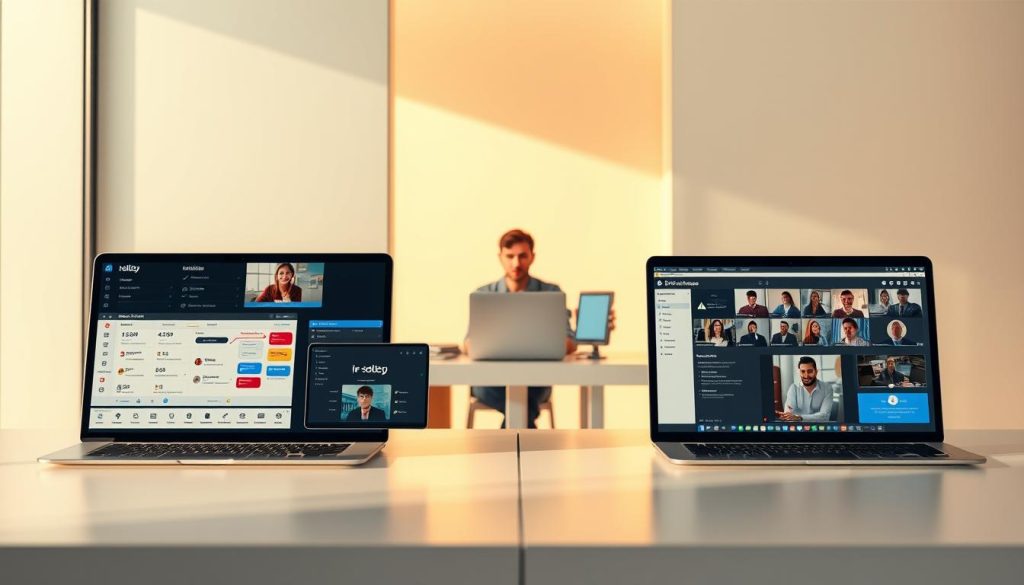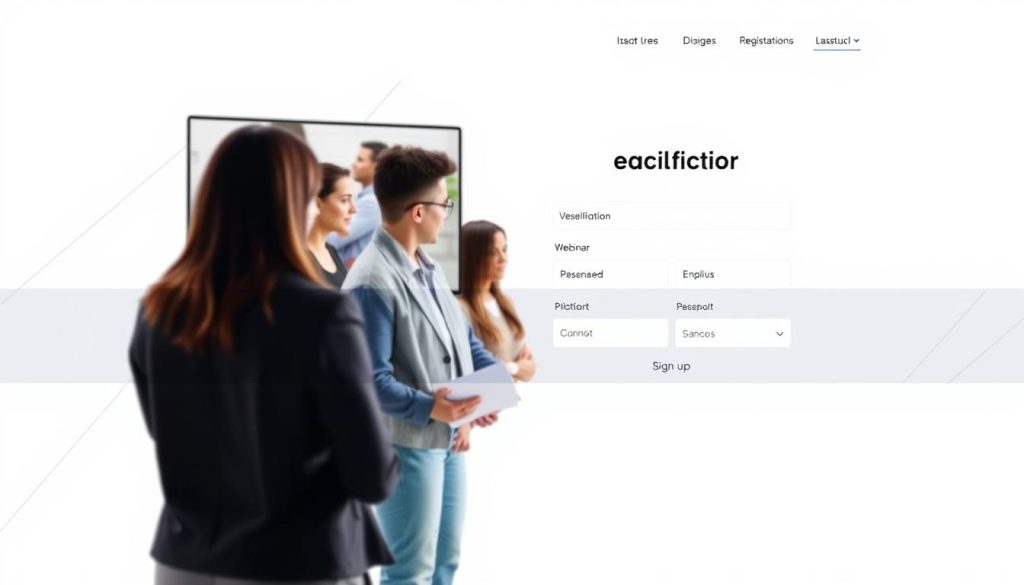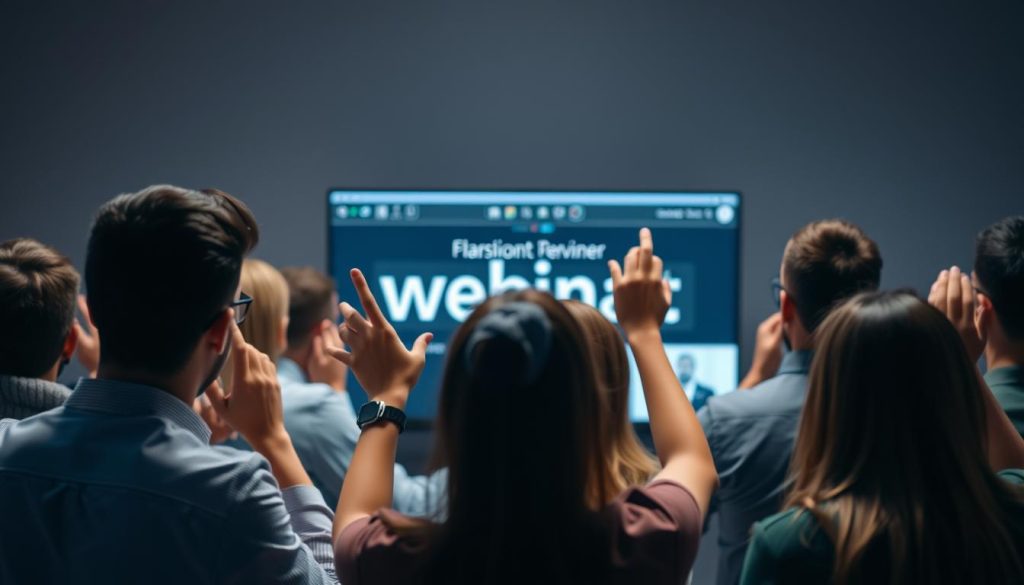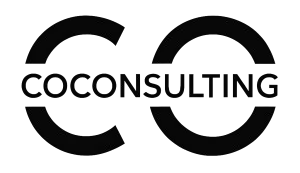We help businesses thrive in a competitive landscape by leveraging effective webinar marketing strategies. In today’s digital age, virtual events have become a crucial tool for generating leads and driving sales.
By hosting a successful online presentation, companies can connect with their target audience, build trust, and ultimately drive conversions. A well-planned approach to virtual event promotion is essential for maximizing the potential of webinars.
We will explore the importance of online presentation tips and strategies that can help businesses succeed in the world of webinar marketing.
Key Takeaways
- Effective webinar marketing strategies drive leads and sales
- Virtual events help businesses connect with their target audience
- A well-planned approach maximizes webinar potential
- Online presentation tips are crucial for success
- Webinar marketing strategies can be a game-changer for businesses
Understanding the Importance of Webinar Marketing
The importance of webinar marketing lies in its ability to engage audiences and foster meaningful connections. We leverage webinars to drive business growth, enhance brand visibility, and generate quality leads.
Benefits of Webinars for Businesses
Webinars offer numerous benefits for businesses, including enhanced webinar audience engagement and improved lead generation capabilities. By hosting webinars, businesses can:
- Establish thought leadership in their industry
- Provide value to potential customers through informative content
- Utilize virtual conference tactics to create immersive experiences
These benefits contribute to a robust marketing strategy that drives results.

Key Statistics on Webinar Effectiveness
Research underscores the effectiveness of webinars in achieving marketing goals. For instance, webinars are known to drive significant results, helping generate an average of six new content pieces and serving as a qualified webinar lead generation tool.
| Statistic | Value | Implication |
|---|---|---|
| Average new content pieces generated per webinar | 6 | Enhances content marketing strategy |
| Lead generation quality | High | Improves sales funnel efficiency |
| Attendee engagement | Interactive | Fosters meaningful connections |
For a deeper dive into creating a successful webinar marketing strategy, we recommend exploring resources like On24’s Webinar Marketing Strategy Guide, which provides actionable insights and best practices.
Choosing the Right Webinar Platform
With numerous webinar platforms available, choosing the one that aligns with your business goals is more important than ever.
We understand that the success of your digital event planning hinges on selecting a platform that meets your specific needs. When it comes to virtual seminar promotion, the webinar platform is not just a tool, it’s the foundation upon which your entire online event is built.
Features to Look For
When evaluating webinar platforms, there are several key features to consider. Analytics and reporting capabilities are crucial for understanding attendee engagement and measuring the success of your webinar. Ease of use is another important factor, as it directly impacts both your experience and that of your attendees.
- Integration with other tools and platforms
- Customization options for registration pages and emails
- Support for various content formats (video, presentations, etc.)
- Reliable technical support
Comparing Popular Webinar Tools
To make an informed decision, it’s helpful to compare popular webinar tools. Below is a comparison of some of the leading platforms:
| Platform | Key Features | Pricing |
|---|---|---|
| Zoom Webinar | High-quality video, robust analytics, integration with CRM tools | $100-$500 per webinar |
| GoToWebinar | Easy to use, customizable registration pages, strong technical support | $49-$129 per month |
| Webex | Advanced security features, high-definition video, integration with other Cisco tools | $25-$65 per month |
As shown in the table, each platform has its strengths and pricing models. We recommend evaluating these factors based on your specific webinar best practices and digital event planning needs.

Defining Your Target Audience
To maximize the impact of your webinars, it’s essential to define and understand your target audience. Knowing who your audience is, what they need, and how they prefer to engage with online content can significantly enhance the effectiveness of your webinar marketing strategies.
Creating Buyer Personas
Creating detailed buyer personas is a critical step in understanding your target audience. A buyer persona is a semi-fictional representation of your ideal customer based on market research and data about your existing customers. To create effective personas, consider factors such as demographics, job roles, challenges, and behavioral patterns.
For instance, a well-crafted buyer persona might look like this:
| Persona Attribute | Description |
|---|---|
| Name | Marketing Manager |
| Job Role | Responsible for digital marketing campaigns |
| Challenges | Generating leads, measuring campaign effectiveness |
| Preferred Communication Channels | Email, LinkedIn, industry webinars |
Effective Audience Segmentation
Once you have defined your buyer personas, the next step is to segment your audience effectively. Audience segmentation involves dividing your broader audience into smaller, more specific groups based on shared characteristics. This allows you to tailor your webinar content and marketing messages to resonate with each segment.
Effective segmentation can be based on various factors, including:
- Demographic Segmentation: Age, gender, income level, etc.
- Firmographic Segmentation: Company size, industry, job function, etc.
- Behavioral Segmentation: Purchase history, engagement level, etc.
By understanding and segmenting your audience, you can create more targeted and engaging webinars that speak directly to the needs and interests of each group.

Understanding your target audience is not a one-time task but an ongoing process that involves continuous research and adaptation. As you gather more data and insights from your webinars and other marketing efforts, you can refine your buyer personas and segmentation strategies to improve future webinar marketing campaigns.
Crafting Compelling Webinar Content
Webinar content that resonates with your audience is the backbone of a successful virtual event. To achieve this, we need to focus on creating a structured agenda, leveraging storytelling techniques, and incorporating impactful visual aids.
Structuring Your Webinar Agenda
A well-structured webinar agenda is essential for maintaining audience engagement. It should include a clear introduction, a detailed main content section, and a conclusive summary. Key elements to include are:
- Introduction to the topic and speakers
- Main content that provides value to the audience
- Interactive sessions for Q&A and feedback
- A summary or call-to-action at the end
By structuring your webinar in this way, we can ensure that our audience remains engaged throughout the event.
Engaging Storytelling Techniques
Storytelling is a powerful tool in webinar content creation. It helps to make complex information more relatable and memorable. Effective storytelling involves:
- Sharing real-life examples or case studies
- Using narratives to convey key messages
- Creating an emotional connection with the audience
By incorporating these techniques, we can make our webinar content more engaging and impactful.
Incorporating Visual Aids
Visual aids such as slides, videos, and infographics play a crucial role in enhancing the webinar experience. They help to illustrate complex points, keep the audience engaged, and provide a break from spoken content. Best practices for visual aids include:
| Visual Aid Type | Purpose | Best Practices |
|---|---|---|
| Slides | Present information, illustrate points | Keep text minimal, use high-quality images |
| Videos | Provide examples, demonstrate products | Ensure high video quality, keep videos concise |
| Infographics | Visualize data, statistics | Use clear and simple designs, focus on key data points |
By thoughtfully incorporating these visual aids, we can significantly enhance the overall webinar experience and improve lead generation through more engaging digital event planning.

Promoting Your Webinar Effectively
To maximize the impact of your webinar, a well-planned promotion strategy is crucial. We will explore how to create a comprehensive promotion plan that drives registrations and engagement.
Utilizing Email Marketing
Email marketing remains one of the most effective channels for promoting your webinar. Building an email list of potential attendees is the first step. We recommend creating engaging content, such as blog posts or videos, that provide value and encourage visitors to sign up for your webinar.
Once you have a list, craft compelling email campaigns that highlight the benefits of attending your webinar. Use clear, concise language and include a prominent call-to-action (CTA) to drive registrations.
- Create a series of emails to build anticipation and excitement.
- Personalize your emails to address the recipient by name and tailor the content based on their interests.
- Use email analytics to track open rates, click-through rates, and conversion rates to refine your strategy.
Leveraging Social Media Channels
Social media is a powerful tool for promoting your webinar. We suggest creating a social media content calendar that outlines your promotional activities across different platforms.
Use engaging visuals and compelling captions to capture the attention of your audience. Facebook, Twitter, LinkedIn, and Instagram are popular platforms for webinar promotion. Each platform has its unique features and audience, so tailor your content accordingly.
- Share behind-the-scenes content to give a sneak peek into your webinar.
- Utilize paid social media advertising to reach a wider audience.
- Encourage your followers to share your content with their networks.
Partnering with Influencers
Partnering with influencers can significantly amplify your webinar’s reach. Identify influencers in your industry who have a following that aligns with your target audience.
We recommend collaborating with influencers to co-promote your webinar. This can include guest blog posts, social media shoutouts, or even having them as guest speakers on your webinar.
| Partnership Type | Description | Benefits |
|---|---|---|
| Guest Blog Posts | Influencers write guest posts for your blog, promoting your webinar. | Increased credibility, expanded audience. |
| Social Media Shoutouts | Influencers promote your webinar on their social media channels. | Broader reach, increased registrations. |
| Guest Speakers | Influencers participate as speakers on your webinar. | Enhanced credibility, more engaging content. |
By utilizing email marketing, leveraging social media channels, and partnering with influencers, we can create a robust promotion strategy that drives registrations and engagement for your webinar.
Best Practices for Webinar Registration
Effective webinar registration is crucial for maximizing attendance and ensuring a successful online event. The registration process sets the tone for attendee engagement and overall event success.
Optimizing Registration Pages
To convert visitors into registrants, your webinar registration page must be user-friendly and informative. Here are some key strategies to optimize your registration page:
- Clear and Concise Form Fields: Minimize the number of form fields to reduce friction and increase completion rates.
- Compelling Headlines and Descriptions: Use engaging headlines and detailed descriptions to communicate the value of your webinar.
- Prominent Call-to-Action (CTA): Ensure your CTA button is visible and encourages visitors to register.
- Mobile Optimization: Ensure your registration page is mobile-friendly, as a significant portion of registrations may come from mobile devices.

Driving Urgency with Limited Seats
Creating a sense of urgency can significantly boost webinar registrations. By limiting the number of available seats, you can encourage potential attendees to register sooner rather than later.
- Limited Availability: Clearly state the limited number of seats available to create a sense of scarcity.
- Countdown Timers: Use countdown timers to visually represent the limited time left to register.
- Exclusive Content: Emphasize that the webinar content is exclusive and not available to everyone, making registration more appealing.
For more insights on creating effective webinar marketing strategies, check out our comprehensive guide on webinar marketing strategy.
Delivering a Professional Webinar Experience
Creating a professional webinar experience involves meticulous planning, from technical setup to audience engagement. To achieve this, we must focus on two critical areas: ensuring a smooth technical setup and testing, and engaging our audience in real-time.
Technical Setup and Testing
A well-executed technical setup is the backbone of a successful webinar. This involves several key steps:
- Choosing the Right Platform: Select a webinar platform that meets your needs, considering factors such as the number of attendees, interactive features, and recording capabilities.
- Testing Audio and Video: Conduct thorough tests of your audio and video equipment to avoid last-minute glitches. Ensure that your internet connection is stable and that you have backup equipment ready.
- Rehearsing Your Presentation: Practice your webinar presentation multiple times to ensure you are comfortable with the material and the technology. This will help you to deliver a confident and polished performance.
For more insights on how content marketing can generate leads, visit Christoph Olivier Consulting.

Engaging Your Audience in Real Time
Engaging your audience in real-time is crucial for maintaining their interest and encouraging participation. Here are some effective strategies:
- Interactive Polls and Q&A Sessions: Use polls and Q&A sessions to involve your audience and gather feedback. This not only keeps attendees engaged but also provides valuable insights.
- Live Chat and Feedback: Monitor live chat and respond to questions and comments in real-time. This helps to create a more interactive and personalized experience.
- Storytelling and Visual Aids: Incorporate compelling storytelling and visual aids to make your content more engaging and memorable.
By focusing on these areas, we can deliver a professional webinar experience that not only engages our audience but also drives desired outcomes. Effective webinar audience engagement is key to a successful virtual conference, and by leveraging online presentation tips and virtual conference tactics, we can ensure a seamless and impactful experience.
Following Up Post-Webinar
The post-webinar phase is crucial for maximizing the ROI of your digital event planning efforts. Effective follow-up strategies can help nurture leads and drive conversions.
Sending Thank You Emails
Sending thank-you emails is a fundamental step in your follow-up strategy. These emails should be personalized and timely, acknowledging attendees’ participation and providing a clear next step.
- Personalize the email content based on attendee engagement and interests.
- Include a clear call-to-action (CTA) to guide the next steps.
- Use email tracking to monitor engagement and follow up accordingly.
Offering Additional Resources
Providing additional resources can further engage attendees and help move them through the sales funnel. Consider offering complimentary content that complements your webinar topic.
- Identify relevant resources that add value to your attendees.
- Use the resources to nurture leads through targeted follow-up campaigns.
- Monitor the effectiveness of these resources in driving conversions.
By implementing these follow-up strategies, you can enhance the overall effectiveness of your webinar lead generation efforts and drive better results.
Measuring Webinar Success
Measuring webinar success is a multifaceted process that involves tracking various metrics to understand its overall effectiveness. To refine your webinar marketing strategies, it’s essential to assess what worked well and what didn’t.
Key Performance Indicators (KPIs)
To measure webinar success, we need to focus on key performance indicators (KPIs) that provide insights into different aspects of the webinar. Some crucial KPIs include:
- Registration Rate: The number of people who registered for the webinar.
- Attendance Rate: The percentage of registered attendees who actually attended the webinar.
- Engagement Metrics: This includes polls, Q&A participation, and chat activity during the webinar.
- Conversion Rate: The percentage of attendees who took a desired action after the webinar, such as making a purchase or signing up for a trial.
By tracking these KPIs, we can gain a comprehensive understanding of our webinar’s performance and identify areas for improvement.
Tools for Analyzing Webinar Metrics
To analyze webinar metrics effectively, we need the right tools. Some popular tools include:
| Tool | Features | Benefits |
|---|---|---|
| Google Analytics | Tracks website traffic, registration, and conversion data | Provides insights into the overall performance of webinar marketing campaigns |
| Webinar Platform Analytics | Offers detailed metrics on attendance, engagement, and participant behavior | Helps in understanding attendee behavior and improving future webinars |
| Email Marketing Software | Tracks email open rates, click-through rates, and conversion rates | Assists in measuring the effectiveness of webinar promotion emails |
By leveraging these tools and tracking the right KPIs, we can measure the success of our webinars and make data-driven decisions to enhance our virtual event promotion strategies.
Integrating Webinars into Your Sales Funnel
Integrating webinars into your sales funnel can significantly boost webinar lead generation and conversion rates. By doing so, you create a seamless journey for potential customers, from initial interest to final purchase.
To achieve this integration effectively, it’s crucial to understand the role of webinars in nurturing leads. Webinars offer a unique opportunity to engage with your audience, build trust, and showcase your expertise.
Nurturing Leads Through Follow-Up
Nurturing leads through follow-up is a critical step in the sales funnel. After hosting a webinar, it’s essential to maintain communication with attendees. This can be achieved through:
- Personalized email campaigns targeting the interests of attendees
- Providing additional resources or content related to the webinar topic
- Utilizing digital event planning tools to track engagement and follow up accordingly
By adopting these strategies, you can keep your brand top of mind and move leads further down the sales funnel.
Converting Attendees into Customers
Converting webinar attendees into customers requires a strategic approach. Here are some webinar best practices to achieve this:
- Offer exclusive deals or promotions to attendees
- Use compelling storytelling and highlight the benefits of your product or service
- Ensure a clear call-to-action (CTA) is present throughout the follow-up process
As noted by marketing expert Neil Patel, “The key to converting leads into customers is to provide value at every stage of the buyer’s journey.” By integrating webinars into your sales funnel and following up effectively, you can significantly enhance your conversion rates.
“Webinars are not just about educating your audience; they’re about creating a connection that can lead to a sale.”
By implementing these strategies, you can maximize the ROI of your webinars and drive business growth.
Future Trends in Webinar Marketing
As we look ahead, webinar marketing continues to evolve, driven by technological advancements and changing audience expectations. We are witnessing a significant shift towards more interactive and personalized experiences.
Hybrid Events
The rise of hybrid webinars is a notable trend, combining the benefits of in-person and virtual events. This format allows for broader audience reach and increased flexibility, making it an attractive option for businesses looking to expand their webinar marketing strategies.
Personalized Experiences
Personalization is becoming increasingly important in webinar marketing. By tailoring content and presentation to specific audience segments, businesses can enhance engagement and conversion rates. Effective virtual seminar promotion relies on understanding the audience and delivering relevant content.
To stay ahead, we must leverage online presentation tips and best practices, ensuring our webinars are not only informative but also engaging and memorable. By embracing these future trends, businesses can maximize their webinar marketing ROI.
